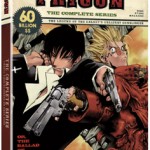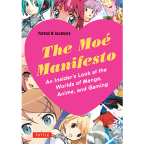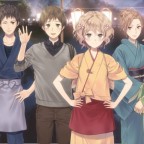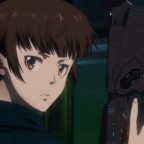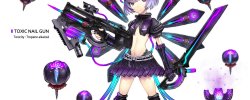Nadav
Black Rock Shooter (TV) Is Surprisingly Good
Black Rock Shooter is not your typical anime series. The idea for BRS came from the artwork used in a music video. The artwork was apparently so popular it brought forth a slew of dolls and figurines. And then, in 2010, BRS broke from the realm of otaku-affiliated toys to the TV screen in a single episode OVA which was called, surprisingly enough, Black Rock Shooter. Perhaps more surprising was the fact that this OVA was released simultaneously in Japan and the U.S., and was a DVD-Blu-ray combo with two Nendroid Puchi (petite) dolls attached to it.
The OVA told the story of Kuroi Matou, a cheerful and carefree junior high student who approaches a transfer student named Takanashi Yomi and become her first friend. While the story’s main focus stayed on Matou, a mystery figure called Black Rock Shooter was shown fighting in a strange apocalyptic world from time to time. After Yomi disappears without a trace Matou discovers that this apocalyptic world is somehow connected to their own and that her friend was absorbed by her alter-ego from that world.
The OVA proved to be lacking. With no prior information to go by other than the artwork and music video it turned into an artistic experiment with little in terms of plot or sophistication. The life of Matou and Yomi were hardly ever interesting, and the entire impact of the OVA rested on multiple short scenes where Black Rock Shooter fought in the artistically provoking apocalyptic world.
More than a year has passed since then, and now a revamped TV series by the same name is being broadcasted. I decided to check it out and see if the series manages to bring a bit more sophistication into this plastic-oriented franchise.
I was pleasantly surprised by what I saw. The show basically took the premise of the OVA, extended it and made it more sophisticated and intriguing. The new series focuses on the emotional aspect of junior high student life. The apocalyptic world of Black Rock Shooter still exists, but here it represents the emotional strifes of the teenage girls in the series. Each troubled teenager is represented by a fighter in the apocalyptic/emotional world, and if they have an emotional confrontation in the real world their alter-ego fight it out in the emotional world. There is a deep connection between the characters and their fighting alter-egos, but it’s only reveled near the end of the series. Suffice to say that if an alter-ego is defeated in the emotional world it’s character in the real world is drained of all emotions regarding the conflict at hand. And Black Rock Shooter is an emotional series indeed. In a smart move, the series tries to shock you with just how intense and insane the emotions of a teenager can be. Although Matou is still at the center of attention, the TV series show multiple views of certain conflicts and more characters are added as time goes by. The show also introduces us to an evil badass school counselor. I’ve never thought I’d see that one coming.
The art style has greatly improved from the OVA. Sadly, the main character designs remain simple to a fault, but are nonetheless more detailed than before. The emotional world, on the other hand, has been reborn in an amazing way. This world is now represented entirely in CG and looks quirk and colorful as it is sinister and surreal. It’s a delight to watch Black Rock Shooter fight in this world, and although the real world is a bit more intriguing this time around, the emotional world is what makes the show the interesting and artistic feat that it is.
If, like me, you were dissapointed by the OVA and hesitated whether or not to watch the series, I promise you it is a much more rewarding viewing experience. I look forward to seeing how the story will wrap up in the following weeks. I’m also eager to see how the Blu-ray will look like.
New Trophy earned!

Yay! I got my first trophy! Who did I get it from? The internet spirits of course.
It’s been three months since Anime Reviews went up, and I think the blog/reviews website has been doing pretty good. I managed to squeeze all the reviews I had the time to write. My goal is always to write a good review, which by my standards means a review that touches on the content of the anime, the quality of DVD/BD and the overall impression. I’ll try to maintain my current pace for reviewing and, of course, blog a bit more.
I’ve only two small grieves with the current state of the website. The first is about the layout of the main page, which I will eventually pay someone to change for me (because I know nothing about HTML, CSS or Jquery). The second are the comments, or more specifically the lack of them. I’d love to see more of you comment on my reviews and blog posts. Like my review? Say it! Dislike my review? Speak up and make your stand. Have a specific question about something I didn’t mention in the review? Fire away!
.hack//Quantum Blu-ray and DVD Review
The .hack//Quantum review is now available in the reviews section and here.
It took me a lot of time to write this review, and for good reasons. You see, I’m a huge .hack fan, to the point where I even read obscurities such as .hack//Zero. So I was pretty excited to watch Quantum. But when I did something strange happened: It didn’t make any sense to me!
So I decided to take up my PSP and finally finish my old save of .hack//Link – the game that chronologically came before this OVA. Only after playing the game a bit, and watching the OVA a second time, did I understand .hack//Quantum’s plot to the fullest. Well, except for the Sophia part. What the hell is Sophia?
I hope .hack fans will forgive me for not giving this title a better score, but it’s not hard to see why I scored it the way I did. I look forward to seeing the movie .hack//Beyond the World sometime in the near future in the hope that it will shed more light on the newest iteration of The World.
So what exactly is Fate/Unlimited Blade Works? (spoiler-free)
With Sentai Filmworks’ latest acquisition of the Fate/Unlimited Blade Works movie the entire line of Fate-related anime adaptations is now licensed in the U.S. In fact it is surprising that this movie wasn’t licensed up until now, considering that the original fate/Stay Night series (released by FUNimation Entertainment between 2006-2008) sold very well in the U.S. Even the obscure fighting game Fate/Unlimited Codes and the generic Fate/Extra made it to the west.
Arguably though, it was Aniplex of America’s decision to release Fate/Zero in the West that prompted Sentai to rise to the challenge and license Fate/Unlimited Blade Works.
But what is this movie really about? Is it a new story that takes place before or after Fate/Stay Night? Is it just a recap movie? Or is it something different altogether?
The answer is simple, and I’m going to provide it without revealing any spoilers. Fate/Unlimited Blade Works is the name of the second route in the Fate/Stay Night game. The original Fate/Stay Night game had three routes, two of which were not available when you started the original game. Upon playing the game for the first time only the initial route was available. This route was named Fate/Stay Night (big surprise here huh). This one plays exactly like the Fate/Stay anime, minus one obscene scene that was replaced by a roaring dragon in the anime…
Upon completing this route you were given the choice to start a new game in which several new optional scenes took place. If you made the appropriate choices during those scenes the story would then branch off from the Fate/Stay route and enter a different route called Fate/Unlimited Blade Works. This route was different from the initial route in three important ways: the outcome of some of the battles between the Servants was different, Shiro (Saber’s novice master) took part in the actual fighting instead of just playing a supportive role, and the story revealed who Archer (Rin’s servant) really is.
So while Fate/Unlimited Blade Works is part of the Fate/Stay Night timeline it is in fact a retelling with enough meat on it to appeal to those who know the original series like the back of their hand. The movie can’t really cram the story of the original Fate/Stay Night route, so those who haven’t see the anime will be lost in terms of plot and characters. This movie is all about battles and revelation regarding characters which you are already supposed to know and care about from previous Fate iterations.
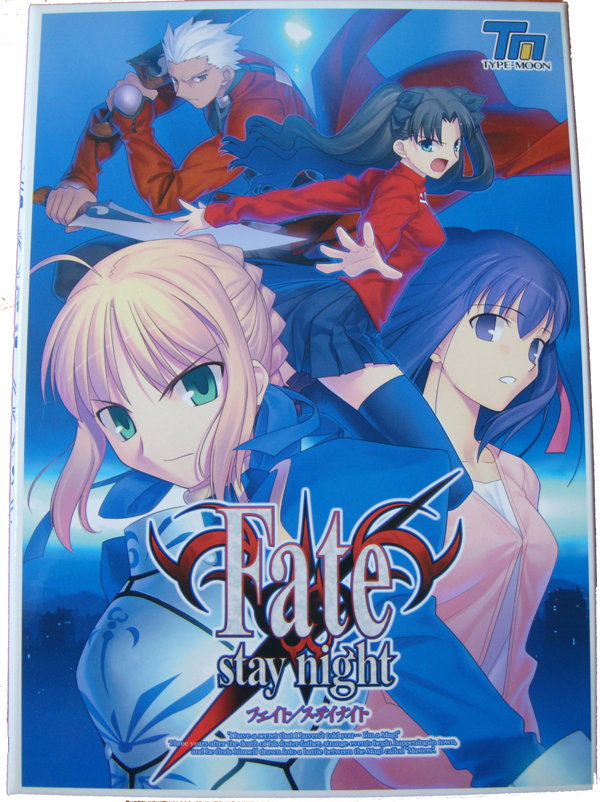 The original game that started it all. Ironically Fate/Stay Night was
The original game that started it all. Ironically Fate/Stay Night was
never released in the U.S. and has no legal English translation.
But what does the name Unlimited Blade Works mean?
Well, it certainly isn’t meaningless as Stay Night was (seriously, why give the game a name with no in-game meaning?). While the name Unlimited Blade Works has a meaning (and we are still in the spoiler-free zone here folks) it is also a little weird name to begin with. You see…there is no Unlimited Blade that Works. The developers of the game had “difficulties” in translating their thoughts into English. The name actually means Unlimited Bladeworks. Think about clockworks – the inner workings of a mechanical clock. Now replace the clock part with swords and make it work with unlimited swords. What you get is Unlimited Blade Works – a Noble Phantasm that only appears in this route of the game and gives it its name.
And that’s it really. I hope this information answers any question you had about this upcoming release. If, by any chance, you are interested in the third route of Fate/Stay Night…let’s just say you’ll have to play the game in order to see it. The third route is called Heaven’s Feel. Unlike the two earlier routes in the game Heaven’s Feel has zero potential to become an anime due to the fact that it is nothing but a gore fest filled with sex and crawling insects. Whether or not this is exactly what you wanted from the Fate franchise to begin with is none of my business.
Trigun DVD Review
The Trigun DVD review is up in the reviews section and here. If you watched the Trigun anime and liked it you might want to check the Trigun manga. The manga starts similiar to the anime but after the first two volumes branches off into a different direction. If I’d have to point out the difference I’d say the manga is a little more sci-fi then the anime.
One thing that often stands out about old anime is the use of Engrish – badly written English that was probably never spell checked by anyone remotely familiar with the English language. Trigun has its fair share of Engrish too: The city of May is misspelled on a sign post that refers to her as Mai. One character is called Rem Saverem, but the production studio horribly misspelled her name and she appears in the population archives as Lem Sayblem. Funny how these things used to pass unnoticed. I’m sure that the animation studios are more aware of these problems today and fix them in time for the DVD/BD release.
Join the club
Recent years have brought forth a slew of anime about school clubs. K-On! had the light music club, Haruhi had the SOS Brigade, MM! had the Second Voluntary Club, Haganai had the “make friends” club and so on. Most anime viewers in the West take these clubs with a grain of salt. Can such clubs exist in real life Japan or are they fictitious creations meant for the sole purpose of spicing up school life series for our enjoyment?
Well, the short answer is no, the SOS Brigade or the “make friends” club would never be allowed to exist in a real high school.
Why not? First of all, every club needs an advisor – a teacher which is responsible for the safety or the students involved in the club. He/She usually have background in the field of said club and can advise on club activities (hence the name advisor). To form a club in a Japanese high school there are certain rules that must be followed, and securing an advisor is on such rule. So even if there were those with the will to form a “host club”, they will have to find a teacher who is willing to be their advisor. That can be quite a challenging feat considering your club activities consist of entertaining girls, drinking tea and eating cake. In high school, most of the teachers are already involved in one or two permanent clubs (such as the kendo club or the music club) and will not take upon themselves a club which seems inappropriate or absurd.
Second, the number of clubs allowed to operate at the same time is predetermined by the each school, so even if you have an amazing idea for a club and did find a teacher who has the time and will to become your advisor, you might end up in a waiting list for club formation. This basically means your club will be on-hold until another club folds or is deemed inactive.
So yes, your average school anime uses clubs which in reality would not have been approved. There are exceptions of course: anime series usually do a good job when it comes to portraying sport clubs. Furthermore, sub categories of popular clubs (the light music club is a sub category of the music/instrumental club) do exist. And lastly, everything I wrote above does not hold in the case of private schools, in which exclusive clubs might be formed.
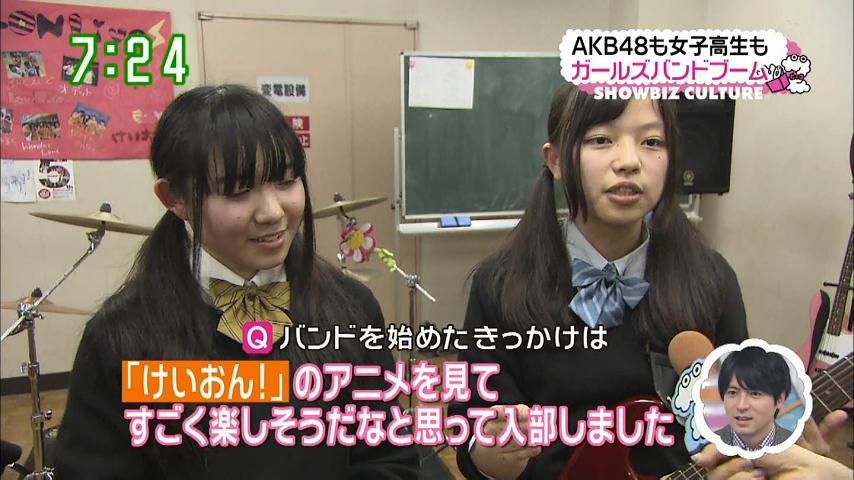 A band inspired by K-On! The subtitles translate to:
A band inspired by K-On! The subtitles translate to:
“I watched the K-On! anime and it looked like good fun so I joined the club”
But wait, I said that the short answer to the question is no. The longer, yet simple, answer is indeed yes – most of these clubs can be formed in real life Japan. But not in high schools. They are made possible in a later time in life, when Japanese students don’t need to worry too much about tests and have exponentially more time on their hands for clubs – their university years. In the university clubs can be formed without the need for an advisor. Moreover university clubs can indulge in much longer and extravagant activities. For example a hiking club, while hard to be found in your average high school, is quite common in Japanese universities. I studied for my Master’s degree in Soka university (located in Tokyo’s Hachioji quarter) and we had tons of these clubs – the ski club, the hiking club, the onsen club (a club for onsen loving folks who want to try onsen in different parts of Japan), the electronic music club, you name it!
I know what you’re thinking: these are all normal clubs. Are there any crazy clubs à la anime series? Yet again the answer is a definitive yes. I was walking on campus one day when I spotted a sign board advertising several new clubs. Among these was “the chocolate lovers’ club”. The informative pamphlet specified it as a club “for chocolate lovers by chocolate lovers. Join us as we sample chocolate from all over Japan and go on expeditions in search of the perfect chocolate delicacy”. Alongside this club was a pamphlet advertising the gourmet club, which worked on a similar premise.
 Three attractive girls and one worthless guy decide to form a chocolate club in their local high
Three attractive girls and one worthless guy decide to form a chocolate club in their local high
school. Each of them works hard to create the perfect chocolate with the dream that one day
they can give it to their secret love as a present. In the final episode it turns out all the attractive
girls were madly in love with the worthless guy and give him their chocolate hearts. The series
will be called Chocolate Club Craze, but after the first episode everyone will refer to it as CCC.
I usually ate my lunch at about 3:30 pm, but one day I finished early and arrived at the cafeteria at around two o’clock. I was surprised to find that several people had connected some tables around the (seldom used) TV monitor and were watching a drama series. I walked in and curiously asked as to what they were doing. It turned out they were the self-proclaimed “drama watching club”. They formed the club to watch their regular drama series, which always aired on the same hour they took their lunch break. Creating the drama watching club didn’t garner them any special rights, except maybe the right the use the TV itself. It was more like an alliance of like-minded drama fans who spent the rest of their day studying at their respective faculties. And that’s exactly the difference between high school clubs and university clubs. Sure, you can join the Karate club even in the university and you will most likely be greeted by Karate experts with years of experience under their 3rd Dan Karate belt. But you can also try to indulge in your personal hobbies and create a less formal club of like-minded folks. The bottom line is this: clubs in Japan, just like any other country, are created to serve as a framework for like-minded people. Be it the Judo club, or the “we Love Plus club”.





